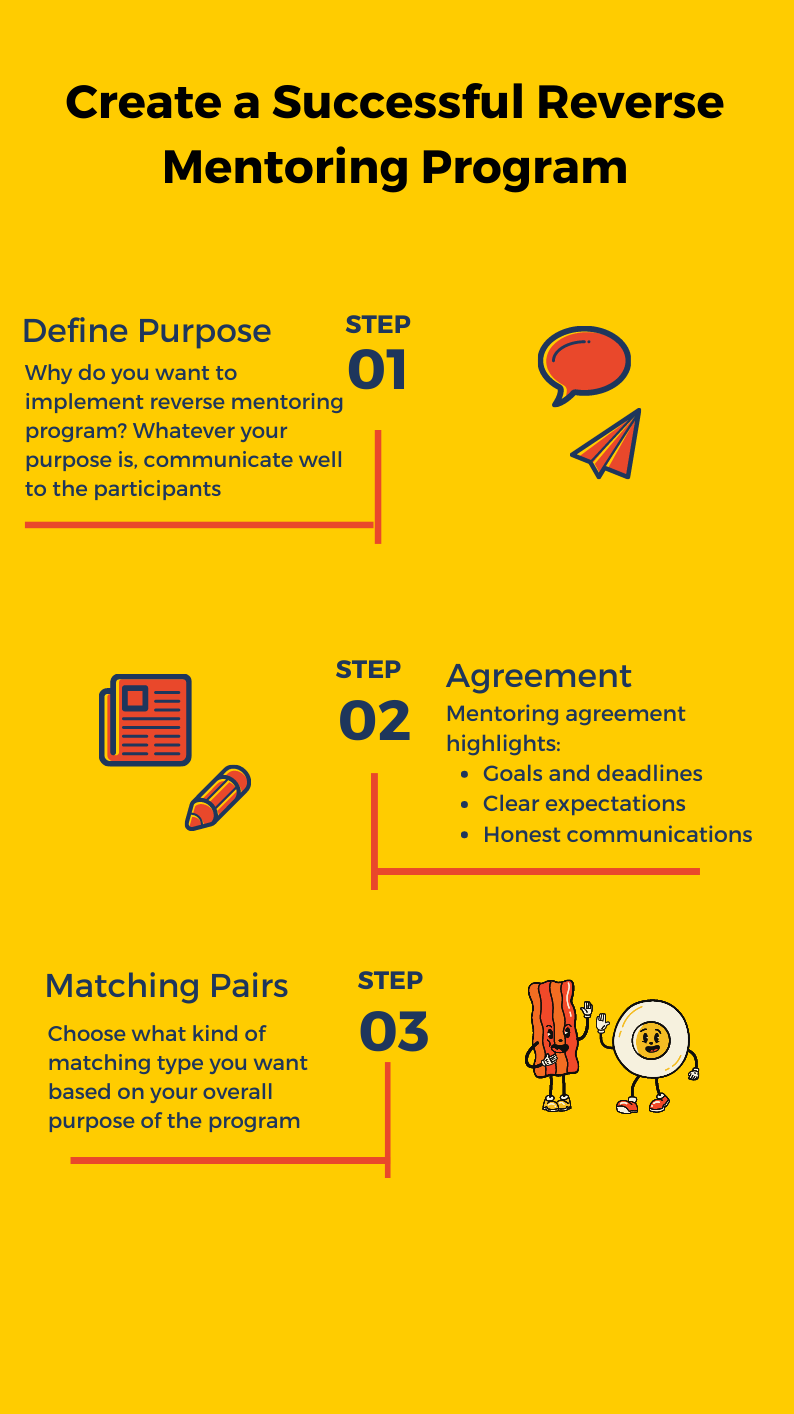
Have you ever considered the idea of being mentored by someone younger and less experienced than you? Reverse mentoring, a concept that has gained popularity in recent years, challenges the traditional notion of mentoring by flipping the roles and expectations. In a corporate setting, it involves senior executives being mentored by younger employees, typically from the millennial or Gen Z generations. While this may initially seem counterintuitive, the benefits of reverse mentoring are numerous. In this blog post, we will delve into the world of reverse mentoring, exploring its definition, how it works, and why it has become such a valuable tool for professional development in the modern workplace.
Reverse Mentoring Meaning
 Reverse mentoring (also known as upward mentoring) is a professional development practice where a less experienced or junior employee assumes the role of a mentor to a more experienced or senior colleague, typically in a different area, often related to technology, diversity, or generational perspectives.
Reverse mentoring (also known as upward mentoring) is a professional development practice where a less experienced or junior employee assumes the role of a mentor to a more experienced or senior colleague, typically in a different area, often related to technology, diversity, or generational perspectives.
Unlike traditional mentoring where knowledge flows from the more experienced to the less experienced, reverse mentoring leverages the unique insights and skills of the younger or less experienced employee to educate and enlighten their more seasoned counterparts.
This approach fosters a two-way learning street, promoting a diverse exchange of ideas, skills, and perspectives within the workplace. Reverse mentoring is particularly effective in bridging generation gaps, enhancing workplace inclusivity, and facilitating a culture of continuous learning and collaboration.
Also read: Know the type of mentoring your employees need
What are the Benefits of Reverse Mentoring?
There are many benefits of upward mentoring for a mentee (senior employee in the mentorship), a mentor (younger employee in the mentorship), and even an organization. Here are a few of the benefits:
For Mentees:
- Help stay up-to-date on technology:
Executives may feel intimidated by new technology at times and hence try to avoid them. One of the main benefits of upward mentoring is that it helps executives stay up-to-date on technology and raise their confidence in working with it.
- Get a break from the routine:
Executives often deal with hectic work schedules on a daily basis. They hardly find time for relaxation. Since mentoring is a more relaxed relation, it gives the mentee a break from the routine; and a dose of freshness.
- Get a different perspective:
There is a difference between the way older and younger employees see or deal with a situation. By involving in reverse mentorship, senior employees get different perspectives and fresh ideas from young professionals.
Not only that, through upward mentoring, junior mentors can help leaders understand how to motivate and retain young employees.
For Mentors:
- Develops leadership skills:
Mentoring is an extremely effective way to improve leadership skills among young employees. By engaging in a mentoring relationship as a mentor, they get to improve their communication skills, practice empathy, learn how to ask questions, and give feedback—all of which are essential to being a good leader.
- Gives them a voice:
Each and every employee of an organization must have the courage to speak up for the betterment of the organization. But in most cases, new employees do not want to voice their opinion or criticize current practices. Through upward mentoring, new employees get a chance to speak up in a low-risk environment. It builds their confidence and empowers them to have their say in critical situations.
- Builds connections within the company:
Mentoring is a unique way to connect employees. Mentors get to build connections with top-level executives through their mentees. Not only that, they get to understand the company culture better and feel more connected to the organization.
-1.png)
For Organizations:
- Promotes diversity and inclusion:
A study by Great Place to Work reveals that after the 2009 recession, companies with an inclusive work culture experienced a 14% gain, outperforming their less-diverse peers by four times. This happened because diversity and inclusion enable creativity, innovation, employee satisfaction, and even an increase in revenue.
While many organizations claim to be diverse, not many of them are truly inclusive. As young employees are likely to be ethnically and racially diverse, reverse mentoring is a great way to promote diversity and inclusion in workplaces.
- Increases employee retention:
According to the 2020 Deloitte Survey, 26% of all millennials surveyed plan to leave their job within a year. This can be due to various reasons, such as poor leadership, poor engagement, or not making the right use of employees’ skills.
Upward mentoring helps employees feel engaged, creates a sense of achievement in mentors, and makes them feel recognized and respected by coworkers. And when employees feel engaged, happy, and satisfied, they are more loyal to their current employers and stick to them for a long time.
- Breaks down generational stereotypes
Reverse mentoring can break down the stereotype that we hear: the younger generation doesn’t work as hard, and the older generation is stubborn. When all age groups interact regularly, each group begins to understand each other, which results in better collaboration throughout the company.
What are the Challenges in Reverse Mentoring?
![]()
As with any new initiative, this type of mentoring faces some challenges. It can be tough for someone who has been in a company for 10 years to take advice from less experienced colleagues. But younger employees have a lot to offer, especially when it comes to technology, innovation, and collaboration.
Some of the challenges that a reverse mentoring program goes through are:
Younger employees are often not seen as experts
Though older employees are skeptical about being mentored by younger mentors, age has no strict correlation with expertise. In fact, younger people can be the experts in a business mentoring relationship.
Because, despite their age, young employees have great expertise in technology, target markets, technical skills, and wise reasoning.
Resistance to learning from someone younger
This is one of the biggest challenges upward mentoring programs go through. It can be misconstrued as an indication that either senior leaders are not doing a good job or are going to be replaced. Moreover, they often do not want to learn from less experienced employees.
Younger employees are reluctant to mentor senior leaders
Younger people do not tend to advise senior leaders. They either don’t feel they will be effective mentors or don’t think that senior employees will be receptive to their advice. Usually, young professionals underestimate their expertise in front of experienced professionals.
In spite of the challenges, the advantages of reverse mentoring cannot be ignored. Besides, challenges can be overcome by educating mentors and mentees on the immense benefits of this mentoring model.
Also Read: 6 Ways to use reverse mentoring
How to Set up a Reverse Mentoring Program?

1. Define the program’s purpose
Every company’s goal is different and so is their purpose for implementing a mentoring program. Before you start, you have to have a clear idea of what you want to achieve through your reverse mentoring program. Why are you doing it?
Is it to bridge the generational gap? Is it to spur innovation by soliciting advice from younger workers? Or is it to improve executive’s knowledge of technology and social media?
Apart from all these objectives, you can have completely different goals for your program:
- Promoting diverse and inclusive culture in the organization
- Increasing knowledge sharing all through the organization
- Improve employee retention rate
- Increasing employee engagement
Whatever your purpose is, make sure you communicate it well to the mentoring participants.
Also, you must set metrics of success for the program. This will help you determine where you are in terms of goals.
Also read: Mentoring Goals: Examples for Inspiration
2. Mentoring Agreements
Mentoring programs can be hard. Executives work on very busy schedules each day. Finding time for their own growth can sometimes look like less priority for them. But if there is no commitment, there is no success.
Mentoring agreement is an invaluable tool for a reverse mentoring program to be successful. It allows participants to understand and agree on their roles and responsibilities, and gain commitment.
A mentoring agreement highlights the following:
- Goals and deadlines setting:Establishing clear goals and a timeline to complete that goal is essential before starting a mentoring relationship. That is the reason it is an essential component of a mentoring agreement. Besides goals and timelines, it also clarifies how to track the progress of the mentee.
- Clear expectations:The agreement explains what mentors and mentees can expect from each other- their time commitment, mode of communication, their boundaries and confidentialities, how mentees want help from mentors, and what kind of support they need to complete their goals.
- Honest communication: Communication is the key to any successful relationship. That’s why mentoring agreement strives for open and transparent communication between mentors and mentees.
In most cases, the document is completed by the mentee as it increases their ownership in the mentoring process. That said, the mentor must review the document, and both the participants must have a mutual agreement.
3. Chose the Right Mentor-Mentee Matches
Compatibility is crucial for any successful relationship. Likewise, choosing the right mentoring pair is essential to create a successful reverse mentoring program.
Keeping the overall purpose of the program in mind, you can choose what kind of matching you want for your program:
- Self-matching: It enables mentees to find their mentors on their own. This matching type is implemented when a mentee knows what they are looking for in a mentor and who can be their best match. Though this type of matching has a higher rate of success, it has some cons like mentees don’t always initiate the searching process and administration has less control over the program.
- Admin matching:It empowers program owners to have a full-control over matching decisions. This matching type is common among leadership and high-potential program formats. It can take a longer time to create mentoring pairs than self matching.
- Hybrid matching: A mixture of self and admin matching, this matching type is implemented when one type is not diverse enough to fulfill the program’s requirements. Hybrid matching is the longest matching process.
If you are matching more than 10–15 mentoring pairs, it can be difficult to find the best match manually. Mentoring software streamlines this process and makes it seamless. Most mentor matching software uses an algorithm that analyses data provided by the participants and suggests the best matches.
Subscribe To The Mentoring Complete Newsletter
1 Comment
[…] What Is Reverse Mentoring And How Does It Work? – Mentoring Complete – https://www.mentoringcomplete.com/reverse-mentoring-complete-guide/ […]
Comments are closed.